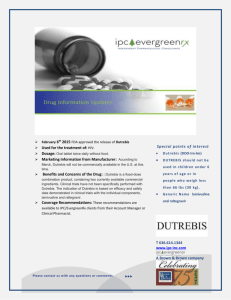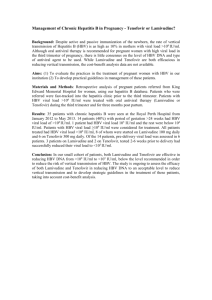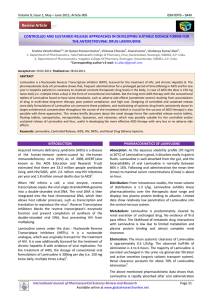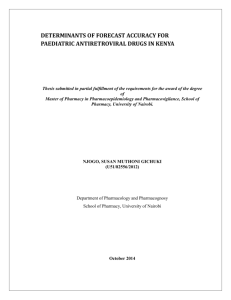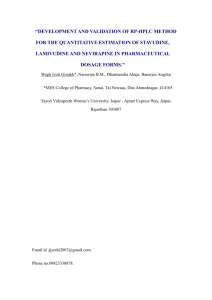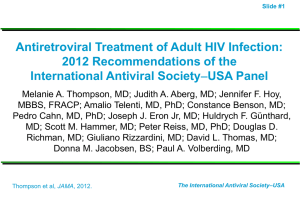Lamivudine CHIP SPC
advertisement
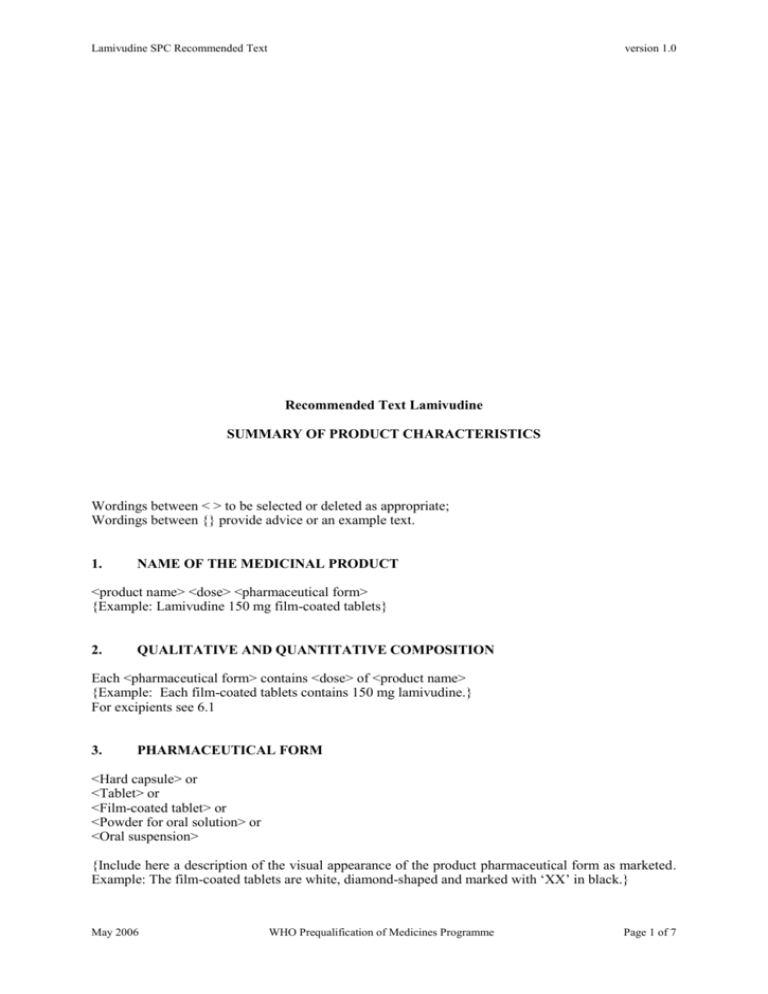
Lamivudine SPC Recommended Text
version 1.0
Recommended Text Lamivudine
SUMMARY OF PRODUCT CHARACTERISTICS
Wordings between < > to be selected or deleted as appropriate;
Wordings between {} provide advice or an example text.
1.
NAME OF THE MEDICINAL PRODUCT
<product name> <dose> <pharmaceutical form>
{Example: Lamivudine 150 mg film-coated tablets}
2.
QUALITATIVE AND QUANTITATIVE COMPOSITION
Each <pharmaceutical form> contains <dose> of <product name>
{Example: Each film-coated tablets contains 150 mg lamivudine.}
For excipients see 6.1
3.
PHARMACEUTICAL FORM
<Hard capsule> or
<Tablet> or
<Film-coated tablet> or
<Powder for oral solution> or
<Oral suspension>
{Include here a description of the visual appearance of the product pharmaceutical form as marketed.
Example: The film-coated tablets are white, diamond-shaped and marked with ‘XX’ in black.}
May 2006
WHO Prequalification of Medicines Programme
Page 1 of 7
Lamivudine SPC Recommended Text
version 1.0
4.
CLINICAL PARTICULARS
4.1
Therapeutic indications
Lamivudine is indicated for the treatment of HIV-1 infection in combination with other antiretroviral
agents.
4.2
Posology and method of administration
Oral use.
Therapy should be prescribed by a physician experienced in the management of HIV-1 infection.
The recommended dose of lamivudine in adults and adolescents over 16 years of age is:
300 mg daily, administered either as 300 mg once daily or 150 mg twice daily.
{text below not applicable for fixed dose preparations}
<The recommended dose of lamivudine for pediatric use is:
Neonatal/Infant dose (infants aged < 30 days): 2 mg/kg twice daily.
From 30 days to 16 years of age: 4mg/kg/ twice daily (maximum dose 300 mg daily). >
Lamivudine may be taken with or without food (1).
Dose adjustment
Liver Disease: No dose adjustment is necessary (2).
Renal Impairment:
It is recommended that lamivudine dose be modified in patients with reduced creatinine clearance
according to the schedule shown below (3, 4).
Adults
Creatinine clearance
(m/min)
50
30-49
15-29
5-14
<5
Lamivudine dose
300 mg daily
150 mg daily
100 mg daily
50 mg daily
25 mg daily
{text below not applicable for fixed dose preparations}
<There is no data available on the use of lamivudine in children with renal impairment. Based on the
assumption that creatinine clearance and lamivudine are correlated similarly in children as in adults it
is recommended that the dose in children with renal impairment be reduced according to their
creatinine clearance by the same proportion as in adults.
Children and adolescents
Creatinine clearance
Lamivudine dose
(mL/min)
8 mg/kg daily
50
30-49
8 mg/kg daily
15-29
5.2 mg/kg daily
5-14
2.6 mg/kg daily
<5
1.4 mg/kg daily
>
4.3
Contraindications
May 2006
WHO Prequalification of Medicines Programme
Page 2 of 7
Lamivudine SPC Recommended Text
version 1.0
Lamivudine is contraindicated in patients with clinically significant hypersensitivity to lamivudine or
to any of the components contained in the formulation.
4.4
Special warnings and special precautions for use
Lamivudine should not be used as part of a triple combination regimen consisting of nucleoside
analogue reverse transcriptase inhibitors (NRTI) solely together with the following NRTIs: didanosine
and stavudine (5), tenofovir and abacavir (6), or tenofovir and didanosine (7) at any time. These
combinations have inferior efficacy compared to other combination regimens. Lamivudine should only
be used in combination with zidovudine and abacavir (8) in the treatment of naïve patients when a
regimen based on a PI or NNRTI cannot be used.
Liver disease
Caution should be exercised when administering lamivudine to any patient with active hepatitis B
infection. Specifically, lamivudine is a potent inhibitor of hepatitis B virus (HBV) replication.
Discontinuation of lamivudine or virologic failure after development of resistance to lamivudine by
HBV may cause hepatic deterioration and a hepatitis flare. Periodic monitoring of liver function tests
and markers of HBV replication is recommended if lamivudine is discontinued in HBV (co-)infected
patients.
4.5
Interaction with other medicinal products and other forms of interaction
Because of overlapping resistance and lack of additive antiretroviral effects, lamivudine should not be
co-administered with emtricitabine.
Co-administration with trimethoprim / sulfamethoxazole results in a 40% increase in lamivudine area
under the concentration curve (9) because of the trimethoprim component. Unless the patient has renal
impairment, no dosage adjustment of lamivudine is necessary. Lamivudine has no effect on the
pharmacokinetics of trimethoprim or sulfamethoxazole.
Lamivudine does not inhibit cytochrome P450 isoform CYP3A.
4.6
Pregnancy and lactation
Pregnancy: Lamivudine is assigned FDA Pregnancy Category C status, i.e. risk cannot be ruled out.
No increased risk of birth defects has been reported for lamivudine ( www.apregistry.com ).
Nursing Mothers: Lamivudine is excreted into the breast milk of lactating mothers (10). Because of
the potential for HIV transmission and adverse effects caused by lamivudine in nursing infants, HIVinfected mothers should be instructed not to breastfeed.
4.7
Effects on ability to drive and use machines
No studies on the effects on the ability to drive and use machines have been performed.
4.8
Undesirable effects
At the beginning of therapy, headache, nausea, vomiting, abdominal pain, diarrhoea and fatigue may
occur: these reactions are usually mild and disappear within a few weeks even if treatment is
continued.
The following adverse events have been reported in controlled clinical trials and case series during
treatment of HIV-1 infection with lamivudine.
The adverse events considered at least possibly related to the treatment are listed below by body
system, organ class and absolute frequency. Frequencies are defined as very common (>1/10),
May 2006
WHO Prequalification of Medicines Programme
Page 3 of 7
Lamivudine SPC Recommended Text
version 1.0
common (>1/100, <1/10), uncommon (>1/1000, <1/100), rare (>1/10,000, <1/1000), very rare
(<1/10,000).
Blood and lymphatic systems disorders
Uncommon: Neutropenia (11, 12).
Nervous system disorders
Common: Headache and insomnia (11, 13-15).
Gastrointestinal disorders
Common: Nausea, abdominal pain and diarrhoea (5, 11, 14).
Skin and subcutaneous tissue disorders
Common: Hair loss (16).
General disorders and administration site disorders:
Common: Fatigue (14).
See also sections 4.4 and 4.5
4.9
Overdose
Limited data are available on the consequences of ingestion of acute overdoses in humans. No
fatalities occurred and the patients recovered. Lamivudine can be removed by haemodialysis.
5.
PHARMACOLOGICAL PROPERTIES
5.1
Pharmacodynamic properties
Pharmacotherapeutic group: <group>, ATC Code <code>
{Example: Antiretroviral, ATC code: J05A F05}
Lamivudine, the negative enantiomer of 2'-deoxy-3'-thiacytidine, is a dideoxynucleoside analogue
which has activity against human immunodeficiency virus and hepatitis B virus. It is metabolized
intracellularly to the active moiety, lamivudine 5’-triphosphate. Its main mode of action is as a chain
terminator of viral reverse transcription. The triphosphate has selective inhibitory activity against
HIV-1 and HIV-2 replication in vitro.
Clinical efficacy:
Lamivudine has been investigated in several randomized, prospective clinical trials combined with
other antiretroviral drugs (17-37). These studies have demonstrated significant decreases in plasma
HIV RNA and increases in CD4 cell counts when used in combination with another nucleoside
analogues and either a NNRTI or a PI. In recent studies by intention-to-treat analysis > 75% of
subjects have achieved plasma HIV RNA < 50 copies/ml after 48 weeks of combination antiretroviral
treatment (28, 37).
HIV-1 resistance to lamivudine involves the development of a M184V amino acid change close to the
active site of the viral reverse transcriptase (www.iasusa.org). M184V mutants display reduced
susceptibility to lamivudine and show diminished viral replicative capacity in vitro.
Cross-resistance conferred by the M184V mutation is limited within the nucleoside/nucleotide
inhibitor class of antiretroviral agents. Zidovudine and stavudine maintain their antiretroviral activities
against lamivudine-resistant HIV-1. Abacavir maintains its antiretroviral activities against lamivudineresistant HIV-1 harbouring only the M184V mutation. The M184V mutant shows a <4-fold decrease
in susceptibility to didanosine; the clinical significance is unknown.
Continuation of lamivudine therapy in those with lamivudine-resistant HIV is associated with slightly
lower plasma viral load and more stable CD4+ lymphocyte counts (15, 38, 39).
May 2006
WHO Prequalification of Medicines Programme
Page 4 of 7
Lamivudine SPC Recommended Text
version 1.0
Lamivudine should not be used as part of a triple combination consisting of NRTIs solely together
with the following NRTI partners: didanosine and stavudine (5), tenofovir and abacavir (6), or
tenofovir and didanosine (7) at any time. These combinations have inferior efficacy compared to other
combination regimens. Lamivudine should only be used in combination of zidovudine and abacavir
(8) in the treatment naïve patients when a regimen based on a PI or NNRTI cannot be used.
5.2
Pharmacokinetic properties
Absorption and Bioavailability:
Lamivudine is rapidly absorbed following oral administration. Bioavailability is between 80 and 85%.
Peak plasma concentrations occur within 1 hour after dosing. In healthy volunteers, at a therapeutic
dose of 150 mg twice daily, mean steady-state Cmax and Cmin of lamivudine in plasma were 1.2 µg/ml
and 0.09 µg/ml, respectively. The mean area under the curve (AUC) over a dosing interval of 12 hours
is 4.7 µg.h/ml. At a therapeutic dose of 300 mg once daily, mean steady-state Cmax, Cmin and 24h AUC
are 2.0 µg/ml, 0.04 µg/ml and 8.8 µg.h/ml, respectively.
Distribution
The estimated volume of distribution is 1.3 l/kg. The observed half-life is 5 to 7 hours. The mean
systemic clearance of lamivudine is approximately 0.32 l/h/kg, with predominantly renal clearance (>
70 %) via the organic cationic transport system. Protein binding is limited.
Metabolism / Elimination
The active moiety, intracellular lamivudine triphosphate, has a prolonged half-life in the cell (16 to 19
hours) compared to the plasma half-life. Lamivudine is predominantly cleared unchanged by renal
excretion.
5.3
Preclinical safety data
Administration of lamivudine in animal toxicity studies at high doses was not associated with any
major organ toxicity.
Lamivudine was not mutagenic in bacterial tests, but showed activity in an in vitro cytogenetic assay
and the mouse lymphoma assay. Lamivudine was not genotoxic in vitro at doses that gave plasma
concentrations around 40-50 times higher than the anticipated clinical plasma levels. As the in vitro
mutagenic activity of lamivudine could not be confirmed in in vivo tests, it is concluded that
lamivudine should not represent a genotoxic hazard to patients undergoing treatment.
The results of long-term carcinogenicity studies in rats and mice did not show any carcinogenic
potential relevant for humans.
6.
PHARMACEUTICAL PARTICULARS
6.1
List of excipients
<Product specific>
6.2
Incompatibilities
Not applicable.
6.3
Shelf life
<Product specific>
6.4
Special precautions for storage
<Product specific>
May 2006
WHO Prequalification of Medicines Programme
Page 5 of 7
Lamivudine SPC Recommended Text
6.5
version 1.0
Nature and contents of container
<Product specific>
6.6
Instructions for use and handling and disposal
No special requirements.
7.
MARKETING AUTHORISATION HOLDER
<Product specific>
8.
MARKETING AUTHORISATION NUMBER(S)
<Product specific>
9.
DATE OF FIRST AUTHORISATION/RENEWAL OF THE AUTHORISATION
<Product specific>
10.
DATE OF REVISION OF THE TEXT
{month year}
Reference List
1. J. Angel, E. K. Hussey, S. Hall, et al, Drug Invest 6, 70 (1993).
2. M. A. Johnson, J. Horak, P. Breuel, Eur. J. Clin. Pharmacol. 54, 363 (1998).
3. A. E. Heald et al., Antimicrob. Agents Chemother. 40, 1514 (1996).
4. M. A. Johnson et al., Br. J. Clin. Pharmacol. 46, 21 (1998).
5. L. R. van et al., AIDS 17, 987 (2003).
6. J. E. Gallant et al., J. Infect. Dis. 192, 1921 (2005).
7. A. Leon et al., AIDS 19, 1695 (2005).
8. R. M. Gulick et al., N. Engl. J. Med. 350, 1850 (2004).
9. K. H. Moore et al., Clin. Pharmacol. Ther. 59, 550 (1996).
10. R. L. Shapiro et al., J. Infect. Dis. 192, 720 (2005).
11. J. M. Pluda et al., J. Infect. Dis. 171, 1438 (1995).
12. J. Fellay et al., Lancet 358, 1322 (2001).
13. L. R. van et al., AIDS 6, 1471 (1992).
14. L. R. van et al., J. Infect. Dis. 171, 1166 (1995).
15. J. J. Eron et al., N. Engl. J. Med. 333, 1662 (1995).
16. I. W. Fong, Lancet 344, 1702 (1994).
17. S. Staszewski et al., N. Engl. J. Med. 341, 1865 (1999).
18. K. E. Squires et al., AIDS 14, 1591 (2000).
19. J. J. Eron, Jr. et al., AIDS 14, 1601 (2000).
20. S. Staszewski et al., JAMA 285, 1155 (2001).
21. A. Carr et al., AIDS 14, 1171 (2000).
22. D. Podzamczer et al., Antivir. Ther. 7, 81 (2002).
23. M. French et al., HIV. Clin. Trials 3, 177 (2002).
24. G. K. Robbins et al., N. Engl. J. Med. 349, 2293 (2003).
25. S. Walmsley et al., N. Engl. J. Med. 346, 2039 (2002).
May 2006
WHO Prequalification of Medicines Programme
Page 6 of 7
Lamivudine SPC Recommended Text
version 1.0
26. J. Gathe, Jr. et al., J. Acquir. Immune. Defic. Syndr. 31, 399 (2002).
27. R. W. Shafer et al., N. Engl. J. Med. 349, 2304 (2003).
28. J. E. Gallant et al., JAMA 292, 191 (2004).
29. E. DeJesus et al., Clin. Infect. Dis. 39, 1038 (2004).
30. E. DeJesus et al., Clin. Infect. Dis. 39, 411 (2004).
31. J. C. Gathe, Jr. et al., AIDS 18, 1529 (2004).
32. A. Rodriguez-French et al., J. Acquir. Immune. Defic. Syndr. 35, 22 (2004).
33. L. F. van et al., Lancet 363, 1253 (2004).
34. A. Vibhagool et al., Curr. Med. Res. Opin. 20, 1103 (2004).
35. K. Squires et al., J. Acquir. Immune. Defic. Syndr. 36, 1011 (2004).
36. G. J. Moyle et al., J. Acquir. Immune. Defic. Syndr. 38, 417 (2005).
37. J. E. Gallant et al., N. Engl. J. Med. 354, 251 (2006).
38. Y. Quan, B. G. Brenner, M. Oliveira, M. A. Wainberg, Antimicrob. Agents Chemother. 47, 747 (2003).
39. A. Castagna et al., AIDS 20, 795 (2006).
May 2006
WHO Prequalification of Medicines Programme
Page 7 of 7
